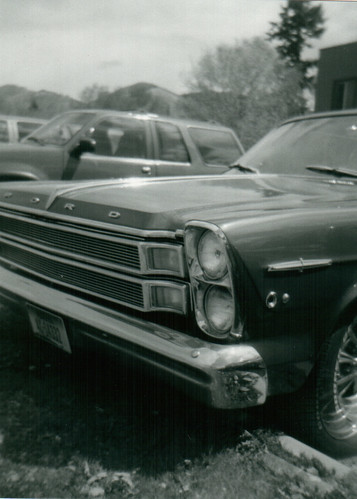My son recently started at a childcare, attending for a few hours each morning. And although he's only been going a short while, I've already noticed that many parents leaving their cars running while dropping their kiddos off. While I can see the need for this in the depths of winter, it's May. It's warm. So I find this behavior curious. I also wonder how much fuel is wasted and how emissions are increased by this phenomenon.
So, I did a bit of research -- and made few surprising discoveries along the way.
First, some not very surprising but still quite troubling statistics. According to the HCF, Americans waste millions of gallons of gas each year via voluntary idling -- this means that any idling that is not a direct result of waiting in standing traffic, such as at stop lights or on backed up roads. In fact, we may be wasting as much as 3.8 million gallons of gas per day through voluntary idling. And that translates to 40,000 tons of carbon dioxide being needlessly emitted -- again, per day.
If we collectively eliminated five minutes of voluntary vehicle idling everyday, we'd save 1.4 billion gallons of gas and 13 million tons of carbon dioxide emissions per year.
That's a lot.
Translating that into individual family financial figures, the HCF states that by eliminating just five minutes of voluntary idling, families driving vehicles with small engines would save $113 annually, and those driving eight cylinder engines would save $241 annually.
And that's only by eliminating five minutes of voluntary idling. I know that it takes me about five minutes to drop my son off at childcare -- if I left my car idling for that time, at the end of the year I'd have spent (conservatively) nearly $4,000 on wasted fuel. Ouch.
There is a myth floating around that leaving your car idling for a short period of time is more fuel efficient and environmentally friendly -- one that I believed. And while this used to be true, our advancing technology has since turned it into fallacy for today's modern vehicles. If you are allowing your car to idle for more than 10 seconds, you are only inflicting unnecessary wear and damage upon the car, wasting gasoline, and creating more emissions. Oops.
Okay, so what about cold weather idling? Well, apparently leaving your car idling for minutes at a time to warm up the engine is also inefficient. A cold engine only needs about 30 seconds of idling to warm it sufficiently, and driving will warm it much better than idling. And for very, very cold engines, using an engine block heater is much more effective -- in practice as well as financially and environmentally.
So . . . I don't know about you, but I feel both convicted and empowered. I'll definitely be altering my car's cold weather warmups this winter, and am excited at how much money we could save by simply turning off our cars when we're not driving them, on top of the benefits to the environment and, as a result, to our health. A big problem with an easy answer? I'm all for it.
What about you? Were you as unaware of the cost of voluntary idling as I was? I'd love to know your thoughts.
Sources:
The Hinkle Charitable Foundation: Anti-Idling Primer
Green Action Centre: Myth Busted -- Idling Wastes Fuel!
South Carolina Department of Health & Environmental Control: Engine Idling (PDF)
Environmental Defense Fund: Attention Drivers! Turn Off Your Idling Engines
So, I did a bit of research -- and made few surprising discoveries along the way.
Idling's Waste
First, some not very surprising but still quite troubling statistics. According to the HCF, Americans waste millions of gallons of gas each year via voluntary idling -- this means that any idling that is not a direct result of waiting in standing traffic, such as at stop lights or on backed up roads. In fact, we may be wasting as much as 3.8 million gallons of gas per day through voluntary idling. And that translates to 40,000 tons of carbon dioxide being needlessly emitted -- again, per day.
If we collectively eliminated five minutes of voluntary vehicle idling everyday, we'd save 1.4 billion gallons of gas and 13 million tons of carbon dioxide emissions per year.
That's a lot.
Translating that into individual family financial figures, the HCF states that by eliminating just five minutes of voluntary idling, families driving vehicles with small engines would save $113 annually, and those driving eight cylinder engines would save $241 annually.
And that's only by eliminating five minutes of voluntary idling. I know that it takes me about five minutes to drop my son off at childcare -- if I left my car idling for that time, at the end of the year I'd have spent (conservatively) nearly $4,000 on wasted fuel. Ouch.
The Myths of Idling
There is a myth floating around that leaving your car idling for a short period of time is more fuel efficient and environmentally friendly -- one that I believed. And while this used to be true, our advancing technology has since turned it into fallacy for today's modern vehicles. If you are allowing your car to idle for more than 10 seconds, you are only inflicting unnecessary wear and damage upon the car, wasting gasoline, and creating more emissions. Oops.
Okay, so what about cold weather idling? Well, apparently leaving your car idling for minutes at a time to warm up the engine is also inefficient. A cold engine only needs about 30 seconds of idling to warm it sufficiently, and driving will warm it much better than idling. And for very, very cold engines, using an engine block heater is much more effective -- in practice as well as financially and environmentally.
Conclusion: The Elimination of Voluntary Idling Saves
So . . . I don't know about you, but I feel both convicted and empowered. I'll definitely be altering my car's cold weather warmups this winter, and am excited at how much money we could save by simply turning off our cars when we're not driving them, on top of the benefits to the environment and, as a result, to our health. A big problem with an easy answer? I'm all for it.
What about you? Were you as unaware of the cost of voluntary idling as I was? I'd love to know your thoughts.
Sources:
The Hinkle Charitable Foundation: Anti-Idling Primer
Green Action Centre: Myth Busted -- Idling Wastes Fuel!
South Carolina Department of Health & Environmental Control: Engine Idling (PDF)
Environmental Defense Fund: Attention Drivers! Turn Off Your Idling Engines









0 comments:
Post a Comment